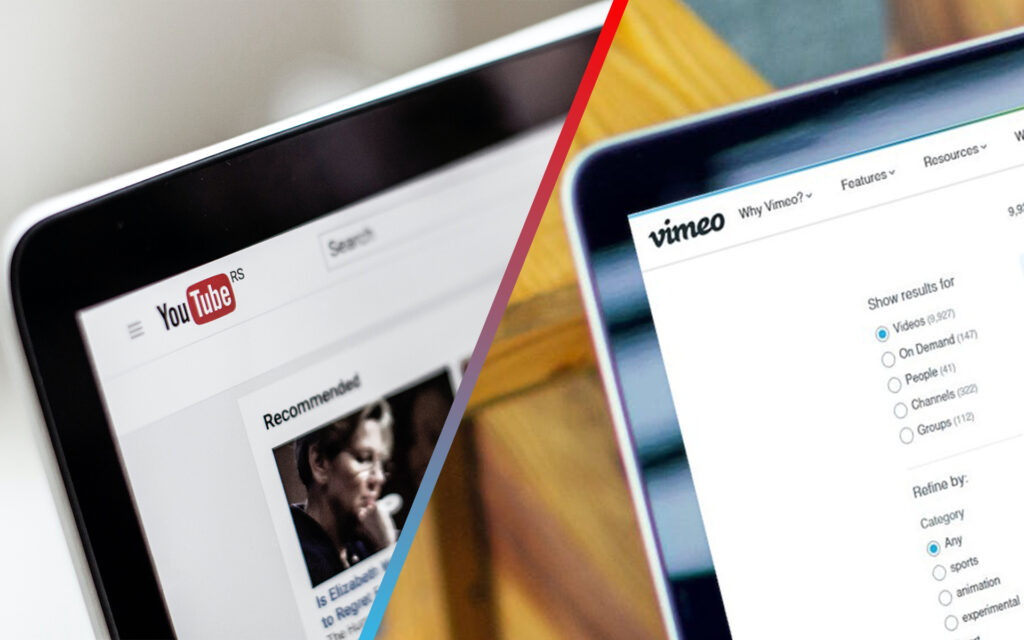YouTube vs Vimeo for Business in 2021

There is no doubt that video creation will become an increasingly important part of any marketing strategy going forward. Video consumption has grown enormously over the past decade and is continuing to do so. It is predicted to become the most searched query in the not too distant future. YouTube and Vimeo are the two most popular video streaming sites. But in 2021, which is better for business, Youtube or Vimeo?
YouTube was formed in 2005 as a free video streaming site. It has rapidly grown to become the second largest search engine and visited website in the world, with 1.8 billion users every month. Over 1 billion hours of video are watched every day, and 500 hours of content is uploaded every minute.
Vimeo was started in 2004 by filmmakers who wanted to share their work. The idea caught on and attracted like-minded people. Today Vimeo is the preferred tool for 70 million creators such as film artists, animators and musicians. Although smaller than Youtube, Vimeo has an ‘arty’ niche.
Youtube vs Vimeo
Audience
For volume there is no contest, YouTube has 1.8 billion users compared to Vimeo’s 240 million. YouTube is available in every country and in more than 50 languages. But it’s size can also be a negative, with so much competition it takes a lot to stand out. The audience can also be ruthlessly critical. Vimeo attracts a smaller, niche audience which has a more community mindset. It is easier to stand out on Vimeo and the audience is less critical.
The Winner: YouTube, you can’t argue with 1.8 billion users.
Youtube vs Vimeo
SEO
YouTube is owned by Google and is the second biggest search engine behind its parent company. If you’re planning to create a video to respond to a particular search query it should be on YouTube. Not only will it appear on search results on the site, but Google seems to favour videos on YouTube over those posted on other video streaming sites. While it is possible to get Vimeo videos to rank for certain keywords it doesn’t have the same SEO capabilities as YouTube.
The Winner: YouTube, google will always prefer its own video platform.
Cost
YouTube is a free service, even for businesses. Vimeo offers a tiered pricing plan starting with a basic free option for individuals for 500mb per week storage, to a £40/month package for businesses offering 5tb of storage with no weekly limits.
The Winner: YouTube, its free, but Vimeo is worth paying for if you are going to use it.
Adverts
YouTube, being a free service, is funded by advertising. Viewers are forced to sit through several seconds of adverts before watching any video which can put people off. However YouTube does offer a premium ad free service for £9.99 a month. As Vimeo is funded by subscriptions, there are no adverts. This also means it isn’t possible to run an advertising campaign on Vimeo which is easy on YouTube. YouTube offers a very user-friendly platform to run adverts, with specific placement requests such as video type, language and location.
The Winner: Vimeo – unless you are looking to advertise of course!
Revenue
For videos that receive 10,000 views or more, YouTube offers a chance to join their partner program. They will then pay a proportion of the advertising revenue to the video creator. Vimeo offers a video on demand service whereby viewers have to pay to see content. So for quality content Vimeo is likely to generate more revenue as YouTube requires a huge number of views before any money is made.
The Winner: It’s a tie, it depends on your content.
Video Quality
The sheer quantity of videos being uploaded onto YouTube means that some compression has to take place to store them all. Although both YouTube and Vimeo support up to 8k resolution, Vimeo serves videos at a higher bitrate than YouTube. So an identical video will appear better quality on Vimeo than on YouTube.
The Winner: Vimeo, a noticeable difference, you want your video to be viewed at its best.
Storage
YouTube offers unlimited, free storage for all accounts. Vimeo charges for storage on a tiered basis with 500mb/week for free and 5tb for £40 a month.
The Winner: It’s a tie. Even though Vimeo has limits, they should be plenty.
Support
With their paid packages, Vimeo offers several layers of technical support that could be a real advantage to businesses who lack video expertise. YouTube does offer free help guides and access to a support group, but for higher levels of personalised support Vimeo is superior.
The Winner: Vimeo, if you’re paying for a subscription, you will always get better support.
Analytics
YouTube has excellent free analytics tools that help users understand who their audience is, where they have come from and how they are engaging. There are statistics on views, traffic sources, retention and gender. Vimeo does offer good analytics tools but only the very basic ones are free the rest have to be paid for.
The Winner: YouTube, free and comprehensive.
Player Options
YouTube’s embed options are very limited. It is possible to change a few parameters such as size, looping, and autoplay. But third party applications are required. With Vimeo Pro and Premium, every visual aspect of the video can be edited, the branding customised and even presets created for different embed types. This is great for different types of videos and all videos can be set up to reflect the business’ branding.
The Winner: Vimeo, this is a big one if you want your video on your website.
Privacy Options
Both YouTube and Vimeo give the option to set videos to private or public (the default setting on YouTube is public), but Vimeo offers a handful of more nuanced, specific privacy options. There is a password protection option to videos, share a video only with people who follow the account, or even hide it from the Vimeo.com community — which could be useful if the plan is to embed the video on the company website and have it only viewable in one place.
The Winner: Vimeo, you have more flexibility.
So which is better for business, YouTube or Vimeo? That really depends largely on the desired goals for the videos. Ross Pike of Koreti sums it up from a small business point of view ‘YouTube is great if you have content people are actively searching for – how to guides, video reviews of products etc. But if you’re looking to embed content on your website, there is only one choice, Vimeo. Vimeo offers huge levels of customisation, styling and embedding tools that give you a much slicker, integrated result. You may have to pay for a pro license, but it’s worth it.’
For a creative community with the ability to connect with other video creators and gain some exposure in a specific niche, Vimeo is a better place to start sharing content. For business goals that revolve heavily around search optimisation, specific queries and adverts, YouTube is the better option. Our advice: use both and assess each video based on your goals and use of that video.
#YouTubevsVimeo for #Business in #2021 #youtube #vimeo #videos
 Epic Heroes Entertainment Movies Toys TV Video Games News Art Pop culture news goodness
Epic Heroes Entertainment Movies Toys TV Video Games News Art Pop culture news goodness



